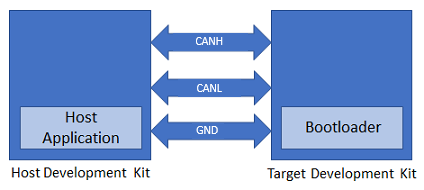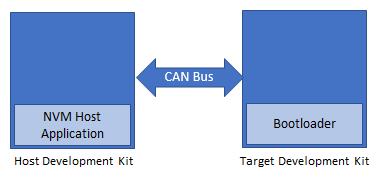1.1.6 PIC32MK MCJ Curiosity Pro Board: Building and Running the CAN Bootloader applications
Downloading and building the application
To clone or download this application from Github,go to the main page of this repository and then click Clone button to clone this repo or download as zip file. This content can also be download using content manager by following these instructions
Path of the application within the repository is apps/can_bootloader/
To build the application, refer to the following table and open the project using its IDE.
Bootloader Application
| Project Name | Description |
|---|---|
| bootloader/firmware/pic32mk_mcj_curiosity_pro.X | MPLABX Project for PIC32MK MCJ Curiosity Pro Board |
Test Application
| Project Name | Description |
|---|---|
| test_app/firmware/pic32mk_mcj_curiosity_pro.X | MPLABX Project for PIC32MK MCJ Curiosity Pro Board |
Setting up PIC32MK MCJ Curiosity Pro Board
PIC32MK MCJ Curiosity Pro Board is used for both Host Development kit and Target Development kit

Connect the Debug USB port (J1) to the computer using a micro USB cable for each board (This will enumerate the Virtual COM Port on PC)
Connect PIC32MK MCJ Curiosity Pro Board to another PIC32MK MCJ Curiosity Pro Board as per the pin connections shown below:
PIC32MK MCJ Curiosity Pro Board - 1 PIC32MK MCJ Curiosity Pro Board - 2 J504, CANH, PIN 1 J504, CANH, PIN 1 J504, GND, PIN 2 J504, GND, PIN 2 J504, CANL, PIN 3 J504, CANL, PIN 3
Building and Configuring CAN Host Applications
Using CAN NVM Host application to send the application binary to Target development kit

If the NVM Host Development Kit being used is other than PIC32MK MCJ Curiosity Pro Board then follow the steps mentioned in Configuring NVM Host application project
Open the NVM host application project host_app_nvm/firmware/pic32mk_mcj_curiosity_pro.X in the IDE
- If a NVM host application project of different development kit is used then open that project in the IDE
Build and program the NVM host application using the IDE on to the Host development kit
- The prebuilt test application image available under host_app_nvm/firmware/src/test_app_images/image_pattern_hex_pic32mk_mcj_curiosity_pro.h will be programmed on to the Target development kit with default host_app_nvm project configuration
Jump to Running The Application
Running the Application
Open the bootloader project bootloader/firmware/pic32mk_mcj_curiosity_pro.X in the IDE
Build and program the application using the IDE on to the Target development kit
- LED1 will be turned-on to indicate that bootloader code is running on the target
- LED1 will also turn on when the bootloader does not find a valid application; i.e. the first word of the application (stack pointer), contains 0xFFFFFFFF
If the test application is being programmed, Open the Terminal application (Ex.:Tera Term) on the computer and configure the serial port settings for Target Development kit as follows:
- Baud : 115200
- Data : 8 Bits
- Parity : None
- Stop : 1 Bit
- Flow Control : None
Press the Switch USER SW on the Host development kit to trigger programming of the application binary
Once the programming is complete,
LED1 on the Host development kit will be turned on indicating success
The target development kit will be reset. Upon re-start, the boot-loader will jump to the user application
If the test application is programmed then LED1 should start blinking and you should see below output on the Target development kit console

Press and hold the Switch USER SW to trigger Bootloader from test application and you should see below output

Press Reset button on the Host development kit to reprogram the application binary
Repeat Steps 4-5 once
- This step is to verify that bootloader is running after triggering bootloader from test application in Step 6
Additional Steps (Optional)
Using CAN NVM Host application
To bootload any application other than host_app_nvm/firmware/src/test_app_images/image_pattern_hex_pic32mk_mcj_curiosity_pro.h refer to Application Configurations
Once the application is configured, Refer to Configuring NVM Host application project for setting up the host_app_nvm project
Once done repeat the applicable steps mentioned in Running The Application
